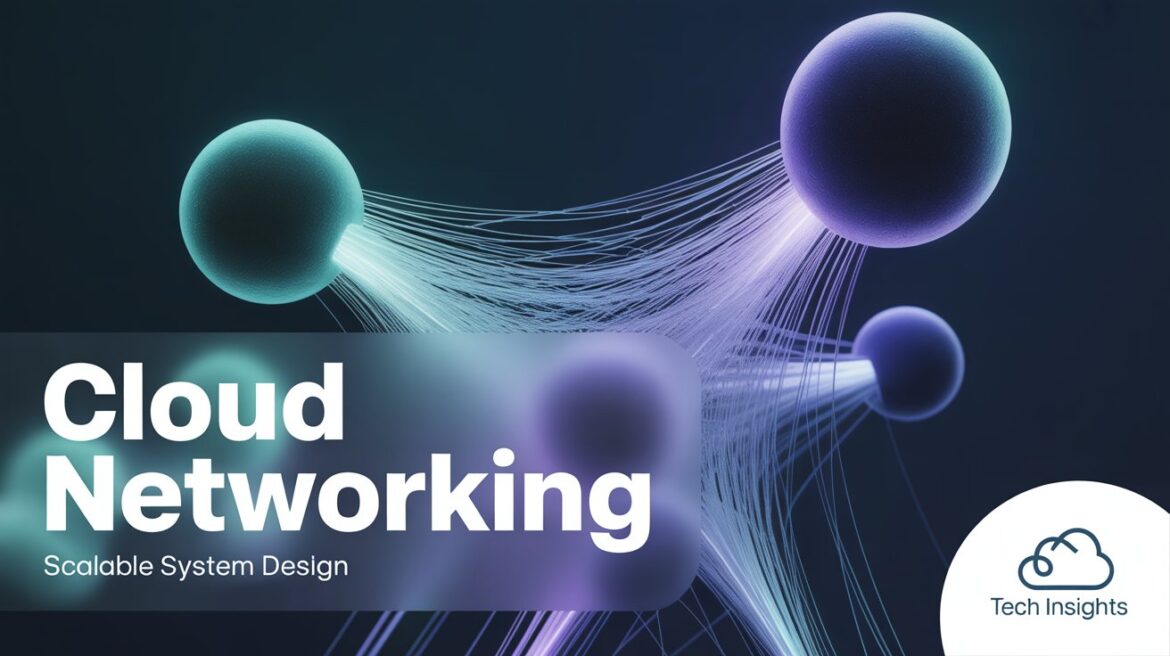Modern applications demand networks that can grow, adapt, and recover seamlessly under fluctuating workloads. Cloud networking provides the foundation for building distributed, highly available architectures without the constraints of traditional data center hardware. By leveraging virtual network constructs, software-defined controls, and automated provisioning, organizations can spin up new services in minutes, scale capacity elastically, and enforce security policies consistently. In this post, we’ll explore key principles, core components, design patterns, and best practices for architecting scalable cloud networks.
Core Principles of Scalable Cloud Networking
- Abstraction & Virtualization
- Virtual Networks: Abstract physical infrastructure into software-defined networks (e.g., AWS VPC, Azure Virtual Network, Google VPC) that you can provision programmatically.
- Network Functions Virtualization (NFV): Replace hardware appliances (firewalls, load balancers) with virtual instances that can scale out on demand.
- Decoupled Control & Data Planes
- Control Plane: Centralized management layer (SDN controllers) that programs forwarding rules.
- Data Plane: Distributed forwarding infrastructure (hypervisor virtual switches or cloud provider fabric) that handles real-time packet movement.
- Elasticity & Autoscaling
- Horizontal Scaling: Add or remove network function instances based on traffic metrics or schedule.
- Load Balancing: Distribute connections evenly across multiple endpoints to prevent bottlenecks.
- Infrastructure as Code (IaC)
- Define all network components (subnets, routing tables, security groups) in declarative templates (Terraform, CloudFormation, ARM Templates).
- Version control network definitions alongside application code to ensure consistency and auditability.
- Observability & Telemetry
- Monitoring: Collect metrics on throughput, latency, error rates, and resource utilization.
- Tracing & Logging: Instrument network paths to diagnose anomalies and optimize routes.
Building Blocks of Cloud Networking
Virtual Private Cloud (VPC) Architecture
- Subnets & CIDR Planning: Segment your VPC into subnets (public, private) across availability zones for fault isolation.
- Route Tables & Gateways: Control north-south traffic via Internet Gateways, NAT Gateways, and egress-only gateways; manage east-west traffic with custom route tables.
Software-Defined Networking (SDN)
- SDN Controllers: Tools like OpenDaylight or vendor-provided controllers orchestrate dynamic flow rules across the fabric.
- Overlay Networks: VXLAN or GRE tunnels encapsulate tenant traffic over the provider’s underlay, enabling multi-tenancy and isolation.
Load Balancers & Service Mesh
- Layer-4/Layer-7 Balancers: Cloud load balancers (ALB, NLB, GCLB) distribute TCP/UDP or HTTP/HTTPS traffic with SSL termination, health checks, and sticky sessions.
- Service Mesh: Istio, Linkerd, or AWS App Mesh manage east-west service-to-service communications, providing traffic shaping, retries, and mTLS encryption.
Network Security Controls
- Security Groups & Network ACLs: Stateful and stateless firewalls enforce port- and protocol-level access at the instance and subnet level.
- Web Application Firewalls (WAF): Protect HTTP/S applications from OWASP top 10 attacks.
- DDoS Protection: Leverage cloud-native services (AWS Shield, Azure DDoS Protection) to absorb volumetric and protocol attacks.
Design Patterns for Scalability
- Multi-AZ and Multi-Region Deployments
- Spread resources across availability zones (AZs) within a region to tolerate AZ failures without downtime.
- For global applications, replicate VPCs in multiple regions behind a geo-DNS/load balancer solution for disaster recovery and low-latency access.
- Micro-segmentation
- Use fine-grained network policies or service mesh rules to restrict communications between microservices, limiting blast radius in case of a breach.
- Event-Driven Network Provisioning
- Trigger IaC pipelines in response to application events (e.g., a new microservice deployment spins up corresponding network paths automatically).
- Blue/Green and Canary Deployments
- Duplicate networking stacks for new application versions (blue/green) and shift a percentage of traffic gradually (canary), rolling back if anomalies appear.
Automation & IaC Best Practices
- Modular Templates: Break IaC into reusable modules (VPC, subnets, security groups) that can be composed for different environments.
- Validation & Testing: Integrate linting tools (tflint, cfn-lint), policy as code (OPA/Gatekeeper), and plan/apply stages in CI/CD pipelines.
- Drift Detection: Regularly compare live network state against IaC definitions to detect manual changes and remediate automatically.
- Secret Management: Store sensitive parameters (API keys, certificates) in vaults (AWS Secrets Manager, HashiCorp Vault) and reference them securely in templates.
Observability and Performance Optimization
- End-to-End Monitoring
- Implement agentless monitoring (CloudWatch, Azure Monitor, Stackdriver) alongside packet-level insights (VPC Flow Logs, NSG Flow Logs) to track traffic flows and anomalies.
- Network Performance Metrics
- Throughput & Bandwidth Utilization: Identify peaks and plan capacity.
- Latency & Jitter: Measure round-trip times between services and clients to detect network congestion.
- Error Rates & Retries: High TCP retransmissions or HTTP 5xx indicate network or endpoint issues.
- Adaptive Traffic Engineering
- Use traffic shaping tools and SDN policies to reroute around congested paths.
- Employ autoscaling policies that factor in network metrics, not just CPU or memory.
Security and Compliance Considerations
- Zero Trust Networking: Authenticate and authorize every flow—never implicitly trust internal traffic.
- Micro-perimeters: Enforce contextual policies (service identity, source IP, geolocation) at the API gateway or service mesh layer.
- Encryption Everywhere: Enable TLS for all in-flight traffic; use customer-managed keys for data at rest.
- Audit Logging: Centralize network configuration changes and access logs in an immutable store for forensic analysis and regulatory audits.
Conclusion
Architecting scalable cloud networks requires a blend of software-defined abstractions, automated provisioning, robust security controls, and comprehensive observability. By adopting VPC best practices, SDN and service mesh technologies, and treating network configurations as code, organizations can achieve agility, resilience, and consistent policy enforcement at cloud scale. As network demands evolve, embracing these design patterns and automation principles will ensure your systems remain performant, secure, and ready to meet future growth.
